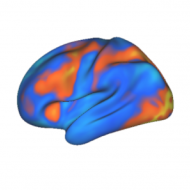I recently watched this talk (below) by Joaquin Fuster. His theories provide a good integration of cortical functions and distributed processing in working and long-term memory. He also has some cool videos of likely network interactions across cortex (in real time) in his talk. Here is a diagram of Dr. Fuster’s view of cortical hierarchies: …
Category Archives: Attention
The Cognitive Control Network
I recently published my first primary-author research study (Cole & Schneider, 2007). The study used functional MRI to discover a network of brain regions responsible for conscious will (i.e., cognitive control). It also revealed the network’s specialized parts, which each uniquely contribute to creating the emergent property of conscious will. I believe this research contributes …
Grand Challenges of Neuroscience: Day 4
After a bit of a hiatus, I’m back with the last three installments of “Grand Challenges in Neuroscience”. Topic 4: Time Cognitive Science programs typically require students to take courses in Linguistics (as well as in the philiosphy of language). Besides the obvious application of studying how the mind creates and uses language, an important …
History’s Top Brain Computation Insights: Day 24
24) Cognitive control processes are distributed within a network of distinct regions (Goldman-Rakic – 1988, Posner – 1990, Wager & Smith 2004, Cole & Schneider – 2007) Researchers investigating eye movements and attention recorded from different parts of the primate brain and found several regions showing very similar neural activity. Goldman-Rakic proposed the existence of …
Continue reading “History’s Top Brain Computation Insights: Day 24”
History’s Top Brain Computation Insights: Day 19
19) Neural networks can self-organize via competition (Grossberg – 1978, Kohonen – 1981) Hubel and Wiesel's work with the development of cortical columns (see previous post) hinted at it, but it wasn't until Grossberg and Kohonen built computational architectures explicitly exploring competition that its importance was made clear. Grossberg was the first to illustrate the …
Continue reading “History’s Top Brain Computation Insights: Day 19”
History’s Top Brain Computation Insights: Day 18
18) Behavior exists on a continuum between controlled and automatic processing (Schneider & Shiffrin – 1977) During the 1970s those studying the cognitive computations underlying visual search were at an impasse. One group of researchers claimed that visual search was a flat search function (i.e., adding more distracters doesn't increase search time), while another group …
Continue reading “History’s Top Brain Computation Insights: Day 18”
History’s Top Brain Computation Insights: Day 17
17) Reverbatory activity in lateral prefrontal cortex maintains memories and attention over short periods (Fuster – 1971, Jacobsen – 1936, Goldman-Rakic – 2000) Patient H.M., with his lack of long term memory but largely intact working (short-term) memory, illustrated a dissociation between these two forms of memory. While long-term memory seemed to rely on hippocampus …
Continue reading “History’s Top Brain Computation Insights: Day 17”
